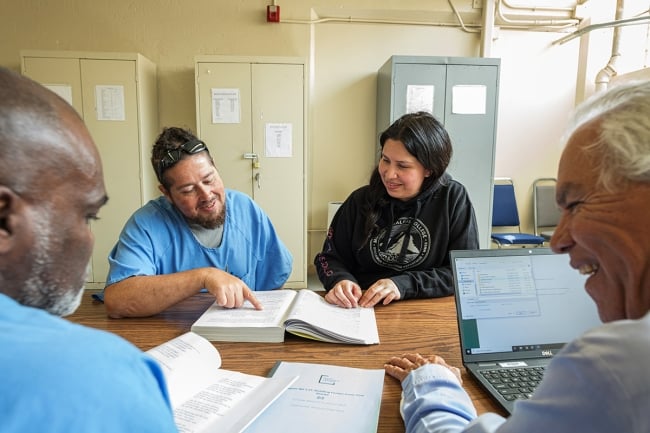You have /5 articles left.
Sign up for a free account or log in.

Mount Tamalpais College students could have a guaranteed spot on a California State University campus under a new agreement.
R. J. Lozada
Students incarcerated at San Quentin State Prison may soon have guaranteed admission to campuses in the California State University system upon release as a part of a new transfer program.
The effort is a partnership with Mount Tamalpais College, a private two-year college based at San Quentin, the only accredited, independent liberal arts college in the country with its main campus based at a prison, according to college officials.
The program, which is in the planning stages, will guarantee Mount Tamalpais students a spot at one of the system’s 23 campuses upon their release if they meet certain course requirements. System and college leaders signed a memorandum of understanding committing to the project in September.
Amy Jamgochian, chief academic officer at Mount Tamalpais, said “almost all” of the college’s students want to continue their studies outside prison, and the college has an adviser and registrar dedicated to helping them transfer, either to community colleges to complete associate degree programs or to universities to earn bachelor’s degrees. She noted that most college-in-prison programs have a main campus outside of the prison where students can continue their studies after their release. But because Mount Tamalpais is based in the prison itself, there isn’t a clear place for students to go. These students are also face “instant barriers” once they’re released, so the easier the transfer process, the better.
Jamgochian said navigating life when newly outside prison has many challenges.
“Supporting yourself and having a roof over your head and maintaining your sobriety and … figuring out how to apply for a job online, all of these really basic things, and then a lot of reuniting with friends and family,” she said. Most students intend to transfer, “but life can be so overwhelming that a sort of disappointingly low number end up being able to do so.”
Mount Tamalpais enrolled 255 students this semester and has 233 people on the wait list. The institution is entirely funded by donors, making classes and textbooks free for students.
‘They Don’t Go Back to Prison’
The California Community College system already has a guaranteed transfer pathway to the CSU, called Associate Degrees for Transfer, or ADT, that automatically admits eligible community college students to a CSU campus, though not necessarily the campus of their choice. Different ADT programs lead to different majors within the CSU system. Some incarcerated students enrolled at California community college programs in prisons can take advantage of the guarantee if their prisons offer the courses required. Data from the system’s chancellor’s office show 320 ADTs awarded to incarcerated students during the 2021–22 academic year and 394 ADTs awarded in 2022–23. The new agreement will extend that same opportunity to students at San Quentin.
Laura Massa, interim associate vice chancellor for academic and faculty programs for the CSU system, said when Mount Tamalpais officials suggested the idea of a transfer pathway, it felt like a natural fit. The system already has a program at 15 of its campuses called Project Rebound that offers formerly incarcerated students financial assistance for textbooks, food, housing and other college costs and connects them with each other and peer advisers to create a sense of community.
A 2023 report on the program found that participating students have collectively earned 500 bachelor’s and 100 master’s degrees since 2019, and the recidivism rate for Project Rebound students is less than 1 percent.
“They don’t go back to prison,” Massa said. “They go off and live the life we were hoping they would live … they will use that education to transform their lives, to improve their family’s lives, their communities’ lives.”
Ray Murillo, assistant vice chancellor of student affairs, equity and belonging at the CSU system, said the timing of the transfer pathway planning coincides with the system expanding Project Rebound. The program is set to launch at four more campuses by the end of this academic year, and the goal is to ultimately extend it systemwide. While the ADT pathway at Mount Tamalpais won’t guarantee students get into a CSU with a Project Rebound program, many formerly incarcerated students are likely to end up on campuses that have the program, which is “uniquely designed for them.”
‘Landing Everywhere They Want’
Jamgochian said Mount Tamalpais will have to add one or two courses to align its offerings with an ADT pathway, but it already has most of the classes the CSU system would require. Meanwhile, Mount Tamalpais leaders are mulling over which ADT would be the best fit for the college. They’re considering a pathway that would transfer students into a legal studies major at these universities, among other options.
Ruth Delaney, associate director of the Unlocking Potential Initiative at the Vera Institute of Justice, said transfer is a fraught, complicated process for students in general, let alone for formerly incarcerated students. Students too often don’t get credit for courses they took and have to retake classes, some states or regions have better transfer policies than others, and if strong policies aren’t in place between a student’s community college and desired university, students have to “knock on a lot of doors” to figure out what credits transfer.
She said the complexities of transfer—having to potentially retake and pay for extra courses and delay their careers—could be especially disheartening to formerly incarcerated students.
“There’s a lot of pressure on people coming home to have a job immediately,” she said. “But also there’s a lot of interest and commitment among returning folks, especially those that go to college, to embark on a meaningful career, in part because you often hear this sense of having lost time to prison and this real motivation to make up for that lost time.”
She added that incarcerated students don’t necessarily have college options to choose from while in prison, so they can’t pick a college based on its transfer possibilities. For example, students at San Quentin haven’t had access to any college programs that offer an ADT.
Developing a transfer pathway from Mount Tamalpais to the CSU seems like a “great development” and a step toward achieving greater “equity across the system,” she said.
Corey McNeil, alumni affairs associate at Mount Tamalpais, said plans for the guaranteed transfer pathway also seem like an acknowledgment of the rigor of the college. McNeil attended Mount Tamalpais while incarcerated and earned an associate’s degree in general education there in 2019. He started a bachelor’s degree program in sociology at San Francisco State University last spring.
“I think there’s that impression or the stigma that education in prison is different from the quality of education that you would receive at a traditional college,” he said. The partnership with CSU “shows that our hard work is being validated.”
McNeil said his transfer process was relatively smooth—all his credits were accepted by the university, and he felt well prepared academically, though he had to get used to using the online student portal and other technology he didn’t have access to while at San Quentin. Meanwhile, staff members at the university’s Project Rebound program have been “very supportive” and send him regular reminders about important academic calendar deadlines.
He said the CSU transfer pathway would be an “awesome” next step for the college, and he hopes the University of California system follows suit.
Jamgochian also believes society at large benefits from these students having easier access to four-year degrees.
“I’m really excited about the possibility, and hopefully probability, of formerly incarcerated people landing everywhere that they want, career-wise, intellectually, in their life path,” she said. These students are “voices and humans who we have forcibly warehoused and hidden in our society … I think the more incarcerated people who take advantage of an opportunity for quality education, the more we’re opening our society and culture up and saying that the democratic promise is actually for everyone, not only certain groups, not only certain people.”





